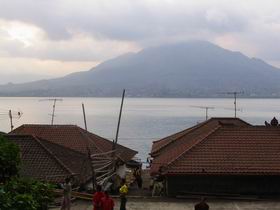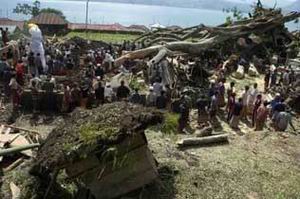A Sad Loss for Trunyan – Pancering Jagat Temple: Trunyan, Bali
 Several years ago, Nick O’Neil of Baliblog fame, and I did several road trips and one place I wanted to show Nick was the Bali Aga village of Trunyan. Located on the shores of Danau Batur under the gaze of Gunung Batur.
Several years ago, Nick O’Neil of Baliblog fame, and I did several road trips and one place I wanted to show Nick was the Bali Aga village of Trunyan. Located on the shores of Danau Batur under the gaze of Gunung Batur.
Besides the graveyard where the Bali Aga do not bury their dead but instead leave the bodies exposed to the elements, I wanted to show Nick the temple of Pancering Jagat – here, the statue of Ratu Pancering Jagat can be found; an ancient statue that is said to possess magical powers.
Unfortunately, we never got to see as the locals demanded stupid amounts of money to enter. I had seen this magnificent temple several times decades ago and was saddened to read in an article by I Wayan Juniartha that a recent storm had devastated it:
Loss of sacred temple rekindles Trunyan faith
The perbekel (village chief) of Trunyan, I Wayan Persa, remembered that Wednesday morning as the day when he woke up with an uneasy feeling of restlessness and anxiety. Over the previous three days, a series of torrential rain, terrifying thunder and gale winds had laid siege on his village of Trunyan.
“It seemed that Mother Nature had sent us a message, an ominous one,” he recalled.
A similar sentiment was shared by some of the village’s elders. In the past, troubled weather had often been followed by a more sinister disaster.
Some 20 years ago, violent winds and severe rains assailed the village a few days before three sacred masks of Sanghyang Brutuk disappeared from the village’s temple.
Persa didn’t have to wait long for the disaster to come. He had barely started his day when several panicked villagers asked him to go to Pancering Jagat temple, in the middle of Trunyan village.
When he arrived, Persa saw no temple. What he saw was an image of haunting destruction.
The giant, 25-meter-tall banyan tree, which for decades had stood majestically next to the temple, had fallen down. Its massive trunk and gigantic branches had obliterated most of the temple’s wall, buildings and shrines.

What was once an impressive — albeit rustic — temple had been replaced by a wild, enormous pile of intertwined twigs, leaves and branches. Their combined weight had shattered several meru, a pagoda-like structure, into pieces.
In silence, the Trunyan people explored the destroyed temple, making their way through crushed bricks and broken branches.
“What terrible mistakes have we done to cause this calamity,” Persa asked in agony.
Pancering Jagat, which literally means “the center of the universe” or “that which binds the universe”, was the spiritual nexus of the Trunyan people. It is the throne of Datonta, their supreme deity and protector.
Inside one of the destroyed meru was a statue of Datonta that stood four meters tall.
Both were believed to be over 10 centuries old.
Two inscriptions issued by the ancient palace of Singhamandawa at the end of the 9th century mentioned permission granted by the king to the Trunyan people to build a temple for Datonta. The inscriptions also detailed the Trunyan people’s holy obligations to the deity.
The Trunyan people pride themselves on being Bali Aga, “the mountain people”, or “the natives of Bali”, and steadfastly practiced their unique brand of Hinduism. They refused to adopt the mainstream Hinduism brought to the island in the 14th century by the invading army of East Java’s Majapahit kingdom.
The Trunyan people’s custom of exposing their dead above ground instead of cremating or burying them; their insistence on using their indigenous and democratic system of priesthood instead of the rigid and exclusive hierarchical system of the Majapahit; and their ultimate homage to Datonta and Pancering Jagat temple are several major characteristics that have distinguished them from the majority of the Balinese people.
Naturally, the destruction of the temple was viewed by the Trunyan people with a mixed feeling of sadness and fear. The sadness was caused by the realization that the disaster might be caused by their own mistakes, by their failure to abide by the ancient customs and rituals.
“Ancient customs dictate that each and every month a special ritual must be held in the temple on the night of the full month. In the last few years, we haven’t been able to completely carry out that custom,” Persa confessed.
The Balinese Hindus, including the Trunyan people, believe that the harmonious balance of nature and man should be maintained and sustained by organizing religious rituals at regular intervals.
“The ritual is our way of giving back to Nature what we have taken from it,” Hindu scholar Ketut Sumarta said.
At the same time, the villagers felt a prevailing fear of having fallen out of the deity’s favor.
“We have to consult a medium to find out whether the disaster was the manifestation of the deity’s dissatisfaction toward us,” local teacher I Wayan Sukasail said.
For Jero Wijaya, a native of the neighboring village of Toyabungkah, the reason for such divine dissatisfaction had already existed: the new road that connected Trunyan with the village of Kedisan.
“The last leg of the road encircles the temple and at several points, lies higher than the temple. I have told the Trunyan people that such an arrangement might influence the sanctity of the temple,” he said.
The road is the most recent development the modernization process had brought to the once isolated village. The “old” Trunyan, a society that was detached, geographically and sociologically, from the majority of Balinese, had ceased to exist, mainly due to this process.
The “new” Trunyan was a society filled with energetic youths who donned modern dress and dreamed modern dreams.
Nowadays, a visitor to Trunyan would find a billiard table in one of the narrow, shadowy alleys of the village. Meanwhile, in nearby houses, groups of local children immersed themselves in the fantasy realms offered by Sony PlayStations.
“A large number of our youths are now working in big cities like Denpasar and Singaraja. They want better lives, better houses, better education, the kind of things you couldn’t get if you stayed here, growing onions on your family’s farm,” local youth Made Tusan said.
The shift from the old to the new Trunyan would certainly change various aspects of the village’s daily and spiritual life.
“Whether it will bring good consequences or bad ones, honestly, we don’t know yet. But there is sincere concern among the elders that to a certain extent, it will erode our conviction and adherence to our customs,” local elder Jero Bau Muncuk Cager said.
The sadness, fear and questions formed an inaudible, background litany as, two days later, hundreds of Trunyan people gathered to clean up the temple. Children and adults, men and women worked in unison to cut up and remove the fallen three.
Dozens of young boys were assigned to clear the most sacred area, the meru of Datonta.
“Only young, unmarried men are allowed to enter the temple’s inner sanctum. In the eyes of the gods, they still possess purity of soul,” the temple priest said.
By midday, the boys had made an astonishing discovery. The meru was severely damaged, but the revered Datonta statue remained intact without any signs of damage. The strongest impact hadn’t been able to inflict any wounds on the statue made of soft sandstone and clay.
Two steel bars that supported the statue also survived unscathed. The bars were part of a restoration project carried out in 1957 by the Dutch expert Krijgsman. His successful work on the then leaning statue and the fact that no misfortune had befallen him after treating the sacred statue had won him the title of Tuan Mangku (Mister Priest) from the locals.
The news lifted the spirits of the people. After these gloomy days, their protector had not abandoned them at all.
“It’s a miracle. It really fills my heart with joy. The Lord is still with us and we are determined to build a new, more beautiful temple for Him,” Persa said.
The boys tore down the outer structure of the meru before carefully and completely wrapping the gigantic statue in white cloth.
“Nobody is allowed to see the face of Datonta, not even the Trunyan people. Only on the full moon festival of the fifth month, the Trunyan people will have a chance to pray before the uncovered face of Datonta. They will take turns in entering the meru and holding a personal audience with our Protector,” Persa said.
As the afternoon sun turned nearby Lake Batur into a vast sheet of liquid gold, the imposing, shrouded figure of Datonta stood in the middle of an immense, deserted plot of land.
The temple might be gone, but the powerful deity was still there.
I Wayan Juniartha